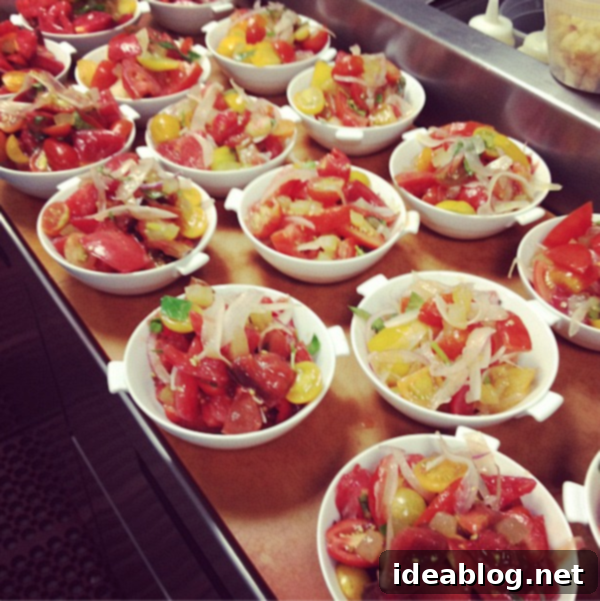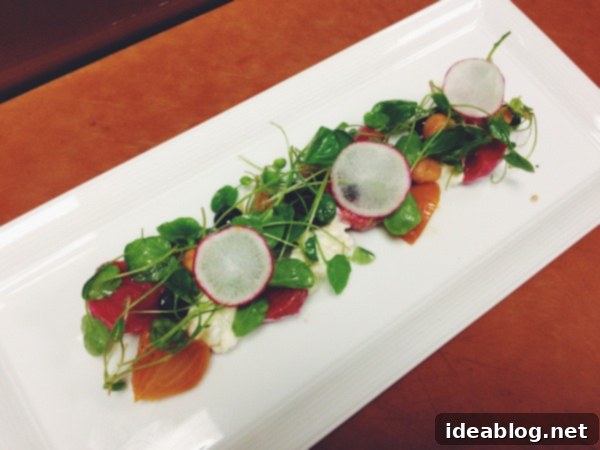From Culinary School to Line Cook: My Unfiltered Reflections on Restaurant Life
This is part of a mini blog post series exploring my culinary journey. You can read more about the series here, or catch up on Part I and Part II.
Where does one even begin when attempting to encapsulate an entire, transformative period of life into a single blog post? This entry, I must confess, has proven to be the most challenging to articulate throughout this entire mini-series. It feels incredibly daunting, almost impossible, to distill my comprehensive experience working in a bustling professional restaurant kitchen into just a few paragraphs.
Yet, as I’ve mentioned before, this is a topic I’ve been eager to discuss for a considerable amount of time. Having meticulously chronicled my journey through culinary school, it only feels right, and indeed necessary, to share the subsequent chapter: the transition from student life to the demanding reality of being a full-time line cook. This period was pivotal in shaping my understanding of the hospitality industry and my own aspirations within the culinary world.
Upon completing six intense months of classroom instruction and practical training, my classmates and I embarked on a mandatory paid restaurant externship. Our culinary institution referred to this phase as an ‘externship’ because we were technically still students, obligated to complete a specific number of hours. However, the restaurant where I was placed, and indeed, my own perception, treated me as a full-fledged, full-time employee. The distinction between ‘student’ and ‘staff’ quickly blurred; I no longer felt like someone merely observing but an active, integral part of the kitchen team, shouldering the same responsibilities as my colleagues.

During my time in culinary school, the impending restaurant externship filled me with an almost paralyzing dread. As paradoxical as it may sound, even as I enrolled in the program, I harbored a strong, albeit quiet, suspicion that restaurant life was not my ultimate calling. I understood its immense value as an educational experience, a necessary rite of passage, but the thought of it still brought a knot to my stomach.
As I progressed deeper into the culinary program, my confidence in my skills steadily grew. The initial worries about simply ‘surviving’ the externship eventually faded, replaced by a new, equally potent fear: the dread of enduring six long, miserable months. These anxieties weren’t baseless; they stemmed from a cocktail of pre-conceived stereotypes about the industry – tales of brutal hours, relentless pressure, and demanding chefs. My culinary school instructors, while supportive, frequently warned us how ‘cushy’ the school environment was compared to the ‘real world’ of professional kitchens. Adding to this apprehension was a particularly negative experience during a restaurant ‘stage’ – essentially a working interview. It was an environment where the resident intern was casually nicknamed “shithead” by the chef. Needless to say, that particular establishment was quickly removed from my list of potential externship sites.
I am immensely relieved and happy to report that the restaurant I ultimately chose for my externship defied most of these daunting stereotypes. It was an oasis of professionalism and camaraderie. In a notoriously male-dominated industry, the number of women on staff actually outnumbered the men – a significant achievement in itself. Instances of cursing and screaming were refreshingly rare, though they did occasionally punctuate the controlled chaos of service. Crucially, no one ever threw anything at anyone, a stark contrast to some of the horror stories often associated with high-pressure kitchens and ‘crazy’ chefs. And perhaps most surprisingly for the industry, most weeks I was scheduled for two days off, occasionally even back-to-back, which felt like an unheard-of luxury.
Every single day offered the privilege of working with exquisite, often luxurious, ingredients. Imagine crafting dishes with fresh white truffles, a truly intoxicating experience that elevated the daily grind. These opportunities were not just about the ingredients themselves, but about learning how to treat them with respect, to enhance their natural flavors, and to create something truly special.
Beyond the ingredients, I learned an immense breadth of practical skills that were never even discussed or touched upon during our formal culinary school training. The pace, the efficiency required, the art of mise en place in a live service environment, and the intricate dance of a busy kitchen line were lessons learned directly on the job. I had the invaluable opportunity to rotate through and work on multiple stations, gaining diverse experience in pastry, cold appetizers, and the hot appetizer/pasta station. I was genuinely considered a vital part of the team, not just an intern passing through. My chefs were truly invested in my education and future, taking the time to teach, mentor, and push me to excel.
My time there was peppered with many, many amazing experiences that will forever be etched in my memory. And a few moments still feel almost surreal. Like the time I found myself under immense pressure (P.R.E.S.S.U.R.E, I tell you!) to prepare dessert for Hillary Clinton, ensuring every detail was perfect. Or the unexpected late-night visit from the starting Lakers basketball team, complete with a last-minute menu request that had us quickly assembling homemade Caesar salads from scratch. These were moments of intense adrenaline and immense satisfaction, proving the unique thrill that restaurant life could offer.
Sounds absolutely amazing, doesn’t it?
Well, this is the part where I pivot to discuss the less glamorous, often difficult, and frankly, not-so-great aspects of restaurant life that often remain hidden behind the allure of fine dining and culinary artistry.
I commenced my externship at the tail end of May 2012. While culinary school kitchens are certainly warm, nothing – and I mean nothing – truly prepares you for the intense, stifling heat of a restaurant kitchen in the peak of summer. Imagine working twelve-plus hours straight, on your feet without a single moment to sit down, in temperatures often exceeding 95 degrees Fahrenheit. It’s an almost unbearable physical endurance test. And that’s still not the worst of it. The truly unpleasant experiences included 13-day work weeks (which I endured once, and that was more than enough) or being called in to work on your sole, precious day off, shattering any hopes of rest or personal time.
The constant, oppressive heat meant I was perpetually drenched in sweat, a state of being that quickly becomes the norm rather than an anomaly. The physical toll was immense.
Despite having what was considered a relatively ‘normal’ schedule for the industry, my days off were invariably consumed by an overwhelming lack of energy. The sheer physical and mental exhaustion meant I rarely, if ever, felt like cooking in my downtime. In fact, for the most part, I actively avoided it. Furthermore, most of my days off fell during the week, making it incredibly difficult to connect with friends and family who worked “normal” 9-to-5 jobs. My partner, Connor, and I often found ourselves working completely opposite hours, creating significant challenges for our shared life outside of work.
While I anticipated some level of sacrifice, the extent to which traditional holidays lost all meaning was still a sobering realization. My respect and admiration for individuals in the restaurant industry who selflessly dedicate themselves, sacrificing holidays and special occasions when most of us are relaxing and enjoying time with loved ones, is boundless. And I hold even more profound respect for restaurants that consciously choose to close on major holidays, prioritizing the well-being of their staff – a truly commendable decision.
And finally, it bears repeating: this is hard, uncompromising work. It’s not just physically demanding but also mentally taxing, all while being notoriously underpaid for the skill, dedication, and hours invested. The professional kitchen is an incredibly tough, high-pressure environment where every second counts. You must possess an exceptional ability to juggle, prioritize, and multitask a million things simultaneously amidst a chaotic, fast-paced setting. Speed is paramount. You have to not only tolerate but genuinely thrive on the adrenaline rush that defines a busy service. You must be fearless, ready to adapt to unexpected challenges and maintain composure under immense pressure. It requires a unique blend of passion, resilience, and unwavering dedication.
Despite all the positive experiences and the invaluable lessons learned (which, for the most part, outweighed the negatives), at some point during my tenure at the restaurant, an undeniable truth became increasingly apparent. While I deeply loved and appreciated the creative side of being in the kitchen – the artistry of crafting dishes, the beauty of ingredients, the precision of technique – my heart ultimately wasn’t in it for the long haul. The demanding lifestyle, the sacrifices required, and the constant intensity slowly but surely convinced me that my culinary path might lead in a different direction. It was a realization born not of dissatisfaction, but of understanding that my passion for food could be expressed in ways that aligned more closely with my desired lifestyle and future.
There’s more to come in the next installment of this series, where I’ll delve further into the lessons learned and the path forward!
